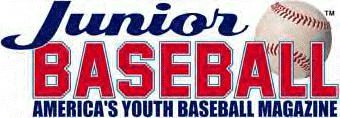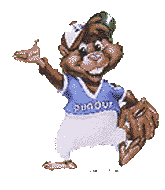
When you select a bat, make sure you select one you can handle with confidence.
Many kids will have their parents' buy a bat because he or she liked the color, shape, handle, logo, brand, etc&ldots;, without any consideration to it's size, weight and appropriateness.
During one of the first practices, many players will grab a bat that initially feels good or that some other player likes and will use that bat the entire year. However, players should hit with a number of different bats during practice to determine what bat gives them the correct feel
by Dave Destler
One of the most important factors in a young player's
enjoyment of the game is
his or her success at the plate.
Besides proper training in the art and science of hitting a baseball, the bat itself plays a big role. Too many well-meaning but uninformed parents buy their kid a bat that is the wrong length or weight, or both. This adds yet another obstacle to the budding player's efforts to succeed.
The choices include different materials, different barrel sizes, different weights, different lengths, and different models for Tee Ball, Youth Baseball, Senior League Baseball, High School baseball, and College ball.
As a rule of thumb, we suggest the
lightest bat of a given length that you can afford.
The high-tech alloys in the
lightest bats cost the most, while inexpensive bats made from cheaper
aluminum - which requires thicker walls for strength - are heavier.
According to Louisville Slugger bat engineer George Manning, "Performance of the bat goes up as the walls are thinned down in aluminum bats. High-strength alloys allow the walls to be thinned while retaining strength needed for durability. A starting player needs to learn to make contact with the ball and hit close to the "sweetspot" of the bat before performance differences in the bats become an important factor."
Length-to-weight ratio is perhaps the most important factor in buying a bat. This is a negative number denoting the amount of ounces the bat weighs less than the amount of inches its length. For example, a 30-inch bat that weighs 20 ounces is a -10. The greatest differential commonly found is -12. for youth bats. Senior League bats are -7, used in Senior Little League as well as Pony, and -5 is for High School.
Some of the mysterious letters and numbers on modern bats indicate the materials with which they're made. For example, 7046 is a lower-end alloy, usually used in cheaper youth bats. CU31 is a fairly common alloy, once the hottest stuff, but now used in the mid-range bats. It gave way to the current crop of C405 alloy bats, generally the top-of-the-line in most cases. Easton's Reflex, Worth's Copperhead, Louisville Slugger's Air Attack2, and DeMarini's all come in C405 (Worth does make lower end Copperheads as well). Easton also has a more modern-yet C500 alloy, and an SC500 which includes Scandium, an element purportedly used in Russian missile casings for strength and lightness. These pricey alloys comprise the popular Redline and Z-Core series.
Bat barrel diameters are usually 2-1/4 inch, 2-5/8 inch, or 2-3/4 inch. The smallest size is required by Little League (up to age 12) as well as some lower divisions of other organizations. Be clear on what limits there might be in your child's league before buying a bat. The larger barrel diameters decrease length-to-weight ratios due to the increased material to make them. They usually have more 'pop' in them and hit the ball harder too.
Worth recently completed a project with a research group to determine the best bat weight for players in youth and adult baseball (see charts). It should be noted that the ideal bat weight for maximum hit ball speed is approximately one ounce heavier than the recommendation. The reason for this is that the research showed there is negligible loss of hit ball speed by reducing bat weight one ounce below the ideal, and the increased bat control with the lighter weight more than compensates.
Atlanta Braves' Chipper Jones recently spoke at a clinic at the ABCA Convention in Atlanta. He was told as a rookie to "swing the heaviest bat you can get around on a 90-mph pitch," so Chipper practiced in the off-season with a 39 oz. bat. In games, though, he uses a 33 oz. bat, unless he's facing Curt Schilling, Kevin Brown, or someone else who brings it in the high 90s. Then he drops an ounce and maybe even an inch.
The point is, even a Major League player goes to a lighter bat to maintain bat speed, which is top priority in hitting. So it's that much more crucial for a young, undeveloped player to have a light enough bat to swing with enough bat speed to hit the ball with some authority.
|
When shopping for a bat, have your child hold it out to his side with the top hand (right hand for right-handed batter). If he cannot hold it straight out for 20 seconds or so without the arm starting to shake and the bat dropping, it's too heavy.
|
|
It's difficult to get a feel for a bat in a store, and even if you could safely swing it there, it's very different from swinging at pitched balls hurtling towards you. If you really want to do some research, take your kid to a local batting cage and have him hit with a selection of cage bats available there on loan. You'll see right away which ones are obviously too small, too big, or too heavy. It's dialing it in to the exact right inch and ounce that's tricky. But if you get close, and even if the bat might be an inch too long (remember - a longer bat puts more weight out further from the hands, which in effect makes it heavier to swing than a shorter bat of the same weight), the player can choke up a little. If he needs to choke up more than an inch, however, go to the next inch-size down.
Players over the age of 13, playing in advanced leagues, club ball, or high school, are usually adept enough to figure out the bat that's best for them, and can borrow teammates' bats to experiment. It's the younger guys that need guidance and the right decisions made by mom and dad (or coach) to ensure they're swinging the right bat for their size, strength, and skill level.
excerpt from

Read an excerpt from "The Superstars
HITTERS BIBLE"
by Bernardo Leonard, Zen Master and
Peter Golenbock
You are visitor
to visit this page!
Since May 9, 2002
Click the button above to go back to the web page or
web site you were at before coming to this page
[Parents] [Players/Kids]
 The
term "Little League" and the Little League logo are
trademarks of Little League Baseball, Inc., Williamsport, Pa.,
extended only to local chartered leagues for purposes of
identification and publicity
The
term "Little League" and the Little League logo are
trademarks of Little League Baseball, Inc., Williamsport, Pa.,
extended only to local chartered leagues for purposes of
identification and publicity
Copyright © 2000 Brookside Little League, Inc. All rights reserved
If you
are interested in advertising on this web site,
e-mail us
for rate information.
Thank you , for visiting Brookside's Little League Web Site
![]()
by
Jon Anderson
jontanderson@juno.com